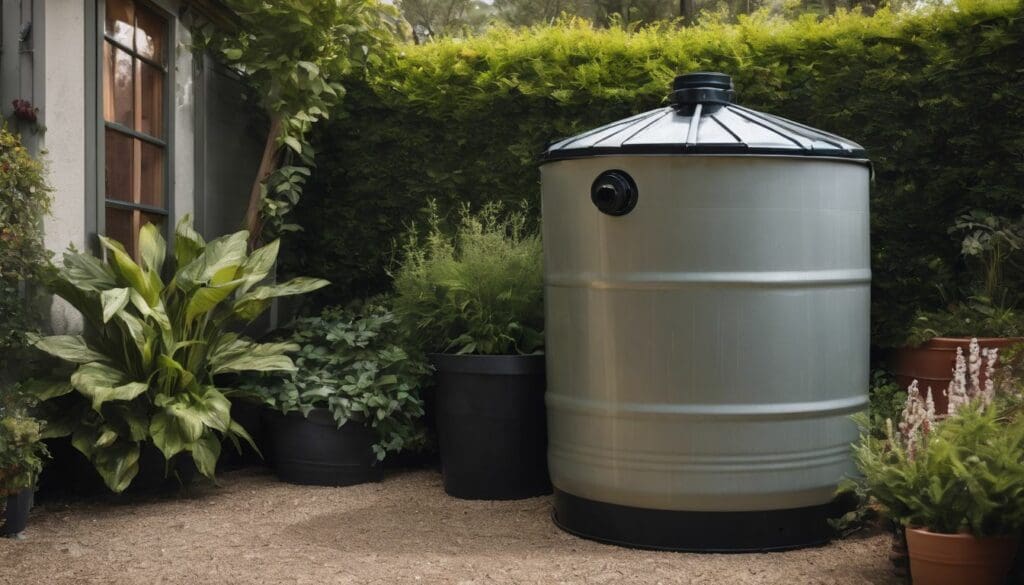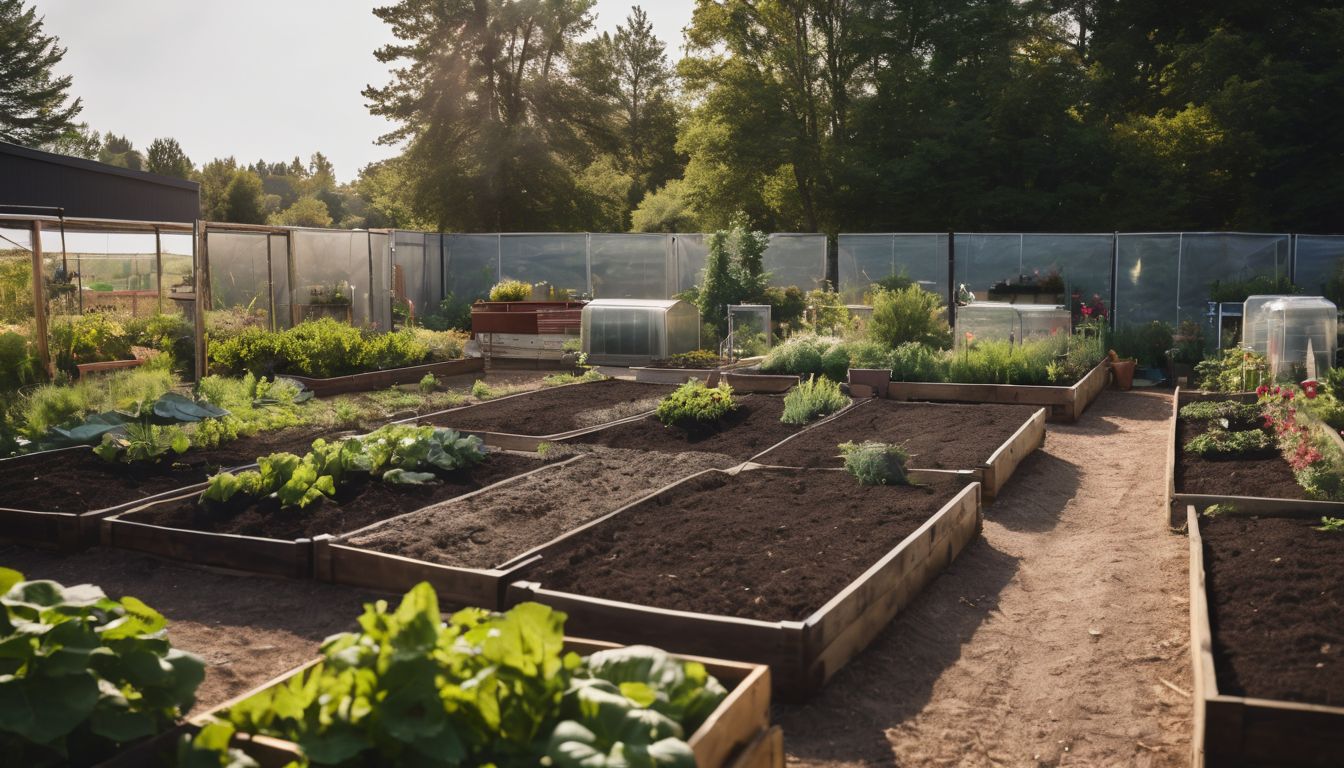Watching the heavens open only for that precious rainwater to meander away down our pathways, we’ve all experienced a pang of regret, not to mention concern for our ever-strained environment.
Like you, we’ve lingered in our gardens, mulling over how marvellous it would be if there were an effortless method to harness this plenitude from above; are you aware that by collecting rainwater, one could slash their water usage by a staggering 40%? We’re eager to guide you through crafting your very own rainwater harvesting system – a pursuit that’s not only within reach but quite gratifying too.
Let’s embark on this journey together and make every drop count!
Key Takeaways
- Installing a DIY rainwater harvesting system can reduce household water use by up to 40%, saving money on water bills and conserving a vital resource.
- Capturing rainwater alleviates the demand for treated municipal water, helping to preserve local reservoirs and minimise environmental impacts such as stormwater runoff pollution.
- A basic collection setup involves using food-grade barrels positioned under downspouts with filters to keep out debris, along with safety measures like secure lids and stable placement to protect against accidents.
- Enhancing your system with multiple barrels, filtration units, first flush diverters, or pumps increases storage capacity and ensures cleaner water is ready for distribution around your property.
- Regular maintenance including cleaning gutters, inspecting connections, and winterisation steps like draining pipes keeps the system efficient over time.
Importance of Rainwater Harvesting
Rainwater harvesting is crucial for saving water and money, as well as reducing strain on municipal water supply. It also brings environmental benefits by promoting sustainable water management.
How it can save water and money
Capturing rainwater directly from your roof can significantly cut down on water bills. By using this free source of water for tasks like watering the garden, washing cars and flushing toilets, we reduce our need to use treated municipal water for non-drinking purposes.
A simple DIY rain barrel system connected to your gutter downspouts can collect a large volume of water during a single rainfall event. This collection reduces the demand on our local supply and ensures that more fresh drinking water is available when we really need it.
Employing rainwater instead of tap water means less energy is used for treating and pumping municipal water, which often translates into monetary savings over time. Plus, investing in a sustainable home water system not only provides immediate reductions in utility costs but also increases the value of our properties by showcasing commitment to eco-friendly practices.
Integrating smart design choices like gravity-fed systems or incorporating advanced features such as rainwater filtration furthers these benefits by providing higher quality reclaimed water at an even lower cost per litre compared to mains supplies.
Reducing strain on municipal water supply
Reducing strain on municipal water supply is crucial for ensuring sustainable use of our community’s water resources. By harvesting rainwater, we can lower the demand for treated potable water, therefore easing pressure on the municipal supply.
This helps to reduce the impact on local reservoirs and ensures that water resources are available for essential needs. Implementing a rainwater collection system not only benefits individual households but also contributes to the overall conservation of municipal water supplies.
Capturing and storing rainwater lessens the reliance on piped water during dry seasons or droughts, thereby reducing stress on municipal treatment facilities as well as distribution networks.
Environmental benefits
Rainwater harvesting offers significant environmental benefits. By capturing rainwater, we reduce the demand on traditional water sources, promoting water conservation and sustainability.
This process also helps to minimise stormwater runoff, which carries pollutants into rivers and streams, thereby preserving our precious natural waterways. Utilising a DIY rainwater system encourages eco-friendly practices while contributing towards a more sustainable future for our planet.
Incorporating rainwater management in your home not only conserves water but also reduces the strain on municipal supplies, minimising energy consumption and lowering carbon emissions associated with treating and transporting traditional water sources.
Building a Basic Rainwater Collection System
Choosing the right materials and location is crucial for a successful rainwater collection system. Follow these steps to assemble your own DIY water collection setup, while keeping safety precautions in mind throughout the process.
Choosing the right materials and location
When building a rainwater collection system, selecting the appropriate materials and location is crucial. We should opt for durable, food-grade barrels or tanks to ensure water quality.
Place the storage containers underneath a downpipe to capture as much rainwater as possible. Ensure that the location is level and sturdy enough to support the weight of the filled containers.
The right materials like UV-resistant plastic or galvanized metal for gutters can enhance durability and contribute to a long-lasting rainwater harvesting setup. It’s vital that we choose an elevated spot with good drainage for positioning our storage system, allowing gravity to aid in water distribution when needed.
Steps to assemble the system
To assemble the rainwater collection system, follow these steps:
- Identify a suitable location for installing the collection barrel, ensuring it is close to a downspout and on stable ground.
- Position the barrel beneath the downspout and secure it in place to prevent tipping or movement.
- Cut the downspout to fit the diverter kit, allowing water to flow into the barrel when it rains.
- Install a debris filter at the entrance of the downspout to prevent leaves and debris from entering the barrel.
- Connect an overflow hose to direct excess water away from the foundation of your home to avoid flooding.
- Place a lid on top of the barrel to keep out mosquitoes and other insects while also preventing evaporation.
- Test the system by running water through the downspout to ensure it flows correctly into the barrel.
Safety precautions
To ensure the safety of your rainwater harvesting system, consider the following precautions:
- Secure all barrels and storage containers to prevent tipping or toppling over during heavy winds or storms.
- Install a secure lid or cover on your collection barrel to prevent children, pets, or wildlife from accessing the water and potentially falling in.
- Position your system away from any potential toxins, such as paint or chemicals stored in a nearby shed, to avoid contamination of the collected water.
- Regularly inspect and maintain your gutters and downspouts to prevent clogging and overflow, which can lead to structural damage and slippery surfaces around the collection area.
- Use caution when climbing ladders or working at heights during installation and maintenance to avoid falls and injuries.
- Store any tools and materials safely out of reach of children, pets, or other household members when not in use.
Advanced Features and Techniques
Explore the benefits of installing a filtration system, using multiple barrels for larger collection, and incorporating a pump for easier distribution. Read on to learn more about maximising the efficiency of your rainwater harvesting system.
Installing a filtration system
To ensure the quality of collected rainwater, installing a filtration system is crucial. Here are steps to incorporate a filtration system into your rainwater harvesting setup:
- Start by selecting an appropriate filter that can effectively remove debris, sediment, and other contaminants from the collected rainwater.
- Place the filter at the entry point of your rainwater collection system to prevent pollutants from entering the storage tanks.
- Regularly clean and maintain the filtration system to ensure optimal functionality and water quality.
- Consider adding a first flush diverter before the filtration system to divert the initial runoff which may contain more contaminants.
- Integrate a UV sterilisation unit after the filtration process as an additional measure to purify the water for various uses.
Using multiple barrels for larger collection
After installing a filtration system, consider using multiple barrels for larger collection. Connect several rain barrels together to increase your water storage capacity. This approach can help you maximise the amount of rainwater collected during heavy downpours and expand your overall harvesting potential.
Multiple barrels also offer more flexibility in distributing stored water across different locations on your property.
Linking up the barrels is relatively straightforward, involving simple modifications to accommodate additional connecting hoses or pipes between them. When doing this, remember that it’s important to maintain proper alignment and elevation between the connected containers to ensure smooth flow and efficient distribution.
Incorporating a pump for easier distribution
- Selecting the right pump: Choose a pump that fits your specific needs and is compatible with your system. Look for energy-efficient models to minimise electricity consumption.
- Installing the pump: Position the pump in a dry, sheltered area close to your storage tank or barrels. Ensure it is securely mounted and connected to your rainwater collection system.
- Setting up the distribution system: Use hoses or pipes to create a network that reaches different areas of your property where water is needed. Make sure there are no leaks or blockages in the distribution lines.
- Implementing a timer or sensor: Consider using a timer or sensor-based system to automate the distribution process, ensuring water is delivered when and where it’s needed most.
- Regular maintenance: Keep the pump clean and check for any signs of wear and tear regularly. Perform routine inspections and servicing to extend the lifespan of the pump.
Maintaining and Winterising Your Rainwater Harvesting System
Regular cleaning and maintenance of your rainwater harvesting system is essential to ensure its longevity and efficiency. In addition, proper winterising techniques will protect the system from freezing temperatures and potential damage.
For best practices for long-term use, consult a professional or reliable online resources.
Regular cleaning and maintenance
To keep your rainwater harvesting system functioning effectively, it is important to conduct regular cleaning and maintenance. Here’s a simple guide to help you stay on top of upkeep:
- Inspect the gutter system for debris and blockages, and remove any leaves, twigs, or other obstructions to enable proper water flow.
- Clean the inlet filter or mesh screens to prevent clogging and ensure optimal water collection.
- Check the storage tank for sediment buildup and use a siphon or pump to remove any accumulated debris.
- Assess the condition of the barrel or tank for cracks, leaks, or signs of wear, and repair as necessary using appropriate sealants or materials.
- Test the functionality of any pumps, filters, or additional features installed in your rainwater harvesting system, making adjustments as needed.
Steps to winterise and protect the system
To keep your rainwater harvesting system in optimal condition through the winter months, we recommend taking the following steps:
- Drain and clean all collection barrels to remove debris and sediment.
- Disconnect and store any hoses or pipes used for water distribution.
- Ensure all valves and taps are turned off to prevent freezing and damage.
- Insulate exposed pipes and fittings using foam sleeves or insulating tape.
- Cover any above – ground components with protective tarpaulin or waterproof covers to shield them from the elements.
- Check and repair any leaks or damages before winter sets in.
Best practices for long-term use
Regularly inspecting and maintaining your rainwater harvesting system is crucial for its long-term effectiveness. This includes checking for leaks, ensuring proper drainage, and cleaning debris from gutters and filters to uphold water quality.
Storing excess water in a secure tank or reservoir will also prevent contamination and evaporation, promoting sustainability.
Protecting the system during winter months by draining pipes, covering exposed components, and insulating storage tanks can prevent damage caused by freezing temperatures. Additionally, consider incorporating overflow measures to direct excess water away from the foundation of your home to safeguard against flooding risks.
Conclusion
In conclusion, building your own rainwater harvesting system is a practical and eco-friendly solution for water conservation. Utilising advanced features such as filtration systems and multiple barrels can enhance its efficiency.
Maintaining the system through regular cleaning, winterisation, and adhering to best practices ensures long-term sustainability. With this approach, you can contribute towards water sustainability while reducing strain on municipal resources – a rewarding investment in the environment and your own future.
FAQs
1. What is a rainwater harvesting system?
A rainwater harvesting system is an ecofriendly way of collecting and storing rainwater from your roof using gutters, creating a water storage system that can be used for various household needs.
2. How does a gutter connected rain barrel work in a rainwater catchment system?
In building your own system, you connect gutters to a barrel where the rainwater flows directly from your roof, allowing you to collect and recycle water efficiently.
3. Can harvested rainwater help with water sustainability?
Yes! By using harvested rainwater for things like watering the garden or flushing toilets, you contribute to water efficiency technologies and support ecofriendly water solutions.
4. Is it complicated to set up my own water reclamation through Rain Water Harvesting?
Setting up isn’t too complicated; it’s about fitting pieces together like making sure your gutter is linked correctly with the storage component of the Rain Water Harvesting System so that it collects maximum rainfall.





